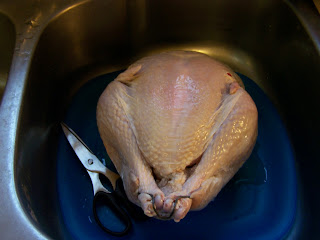Crab rangoon has become a staple of the American 'Chinese' cuisine experience, at least in my part of the country. Originally just a fried wonton filled with cream cheese, it was named for the shape it was folded into before frying. Eventually they evolved to contain actual crab, surimi, or shrimp.
Fong's Pizza in Des Moines specializes in putting favorite 'Chinese' dishes onto pizzas. By in large their most popular is the crab rangoon pizza. My love of actual crab rangoon led me to seek it out and I loved it. I wanted to make it at home and it's quite good!
The Ingredients:
Crust

The ingredients called for in this recipe will make two pizzas. I prefer to use a thin and crispy crust. I have used a cookie sheet sized refrigerated pizza to make a single pizza from the same ingredients that was somewhat decent.
Cream Cheese

I prefer to use onion & chive whipped cream cheese. Today I'm using 1/3 fat regular so it's a little easier on our familial digestive tracts. Whipped cream cheese is easier to spread, but it's best if you leave this out on the counter for a couple of hours before using to soften.
Crab (Surimi)

Flaked-style imitation crab meat is the traditional, but you could also slice up the leg style. We once grabbed lobster delight instead of crab delight and it was exceptionally rich.
Cheese

You really want to get a good cheese for this. I prefer to find a blend that contains asiago. Sargento's 6 cheese Italian blend is what we usually use. You only need a 2 cup package.
Wontons

We get these fried wonton strips from the salad toppings section. If you can't find these you can sometimes find wonton chips or you could fry your own.
Sweet Chili Sauce

When our local grocery sells this pizza as take and bake, they sometimes try to include a cup of sweet and sour sauce that falls flat. Sweet chili sauce has what you need to cut through the other rich toppings.
The Procedure:
First you need to check your crust package or recipe for instructions on prepping the crust. Here's what mine says:

I fired up the oven and placed the crusts on top of parchment lined aluminum pizza pans. The parchment isn't generally required, but our pans are in rough shape after years of usage. Next I poured a small amount of olive oil on and spread it with a small piece of paper towel.

Now you can spread on your cream cheese. I always split one tub evenly on both crusts.

I use an off-set spatula designed for frosting cakes, but it doesn't really matter what you use as long as you get it all over. Cream cheese firms up as it cooks so where you put it is where it will stay.

Now you can open up your package of imitation crab meat and it will probably look like this:

Break it up and pull it apart into more bite sized pieces:

Sprinkle it over your cream cheese base. Spread them out very well because like the cream cheese, they aren't going anywhere.

At this point you could add some optional chopped green onion, but I find that you get enough onion flavor from the cream cheese.
Next you add the cheese. Start by sprinkling around the outside edge and then filling in the middle so you don't end up with too much cold cheese in the center.

After the cheese, I usually sprinkle on the wonton strips. If your crust recipe takes longer than 10 minutes to cook, you may want to add them during baking so they don't burn.
Now you only need to bake them as instructed by your crust instructions. I usually have to bake them one at a time in my oven.

Once they are baked to your liking, you should drizzle on the sweet chili sauce while they are still hot.

Allow a few minutes to cool slightly before slicing and enjoy!


The Recipe:
Crab Rangoon Pizza
Makes 2 pizzas
Ingredients:
1 pkg. Mama Mary's Thin & Crispy pizza crusts (or 2 crusts of your choice)
olive oil
1 8 oz tub of chive & onion cream cheese
1 8 oz pkg imitation crab meat, flake style
1 bunch of green onions, chopped (optional)
8 oz of shredded cheese, preferably with Asiago
2 to 4 oz of fried wonton strips
Thai sweet chili sauce, for drizzling
Preheat oven to 450 (or follow instructions for you pizza crust). For each pizza, lightly brush crust with olive oil then spread half of the cream cheese. Separate the pieces of crab meat and spread half over each pizza then sprinkle with the chopped green onions. Spread the cheese evenly over the top and then add wonton strips to your liking. Reduce oven temp to 425 and bake pizza for 7 to 10 minutes (see your crust instructions). Remove from oven and drizzle with the sweet chili sauce. Let sit for 2-3 min before cutting.

























